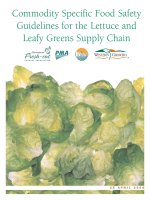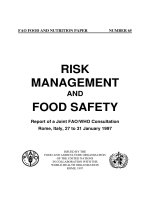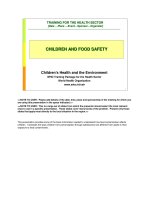fermentation and food safety 2001 - adams & nout
Bạn đang xem bản rút gọn của tài liệu. Xem và tải ngay bản đầy đủ của tài liệu tại đây (18.35 MB, 312 trang )
Fermentation
and
Food Safety
Editors
Martin
R.Adams,
MSc,
PhD
Reader
in
Food Microbiology
School
of
Biomedical
and
Life
Sciences
University
of
Surrey
Guildford,
United Kingdom
M.
J.
Robert
Nout,
PhD
Associate Professor
Laboratory
of
Food Microbiology
Wageningen University
Wageningen,
The
Netherlands
AN
ASPEN
PUBLICATION®
Aspen Publishers, Inc.
Gaithersburg, Maryland
2001
The
author
has
made every
effort
to
ensure
the
accuracy
of the
information herein. However, appropriate
infor-
mation sources should
be
consulted, especially
for new or
unfamiliar
procedures.
It is the
responsibility
of
every
practitioner
to
evaluate
the
appropriateness
of a
particular opinion
in the
context
of
actual clinical situations
and
with
due
considerations
to new
developments.
The
author, editors,
and the
publisher cannot
be
held responsible
for
any
typographical
or
other errors
found
in
this book.
Aspen Publishers, Inc.,
is not
affiliated
with
the
American Society
of
Parenteral
and
Enteral Nutrition.
Library
of
Congress
Cataloging-in-Publication
Data
Fermentation
and
food
safety/
Martin
R.
Adams
and MJ.
Robert Nout
p. cm.
Includes bibliographical references
and
index.
ISBN
0-8342-1843-7
1.
Fermented
foods.
2.
Food industry
and
trade—Safety
measures.
I.
Nout,
M. J.
Robert.
II.
Adams, Martin,
R.
TP371.44.F472001
660'.28448—dc21
00-051087
Copyright
©
2001
by
Aspen Publishers, Inc.
A
Walters
Kluwer
Company
www.aspenpublishers.com
All
rights reserved.
Aspen Publishers, Inc., grants permission
for
photocopying
for
limited personal
or
internal use.
This consent does
not
extend
to
other kinds
of
copying, such
as
copying
for
general distribution,
for
advertising
or
promotional
purposes,
for
creating
new
collective works,
or for
resale.
For
information, address Aspen Publishers, Inc., Permissions Department,
200
Orchard Ridge Drive, Suite 200, Gaithersburg, Maryland 20878.
Orders: (800) 638-8437
Customer Service: (800) 234-1660
About Aspen Publishers
• For
more than
40
years, Aspen
has
been
a
leading professional publisher
in
a
variety
of
disciplines.
Aspen's
vast information resources
are
available
in
both print
and
electronic
formats.
We are
committed
to
providing
the
highest quality
information
available
in the
most appropri-
ate
format
for our
customers. Visit Aspen's Internet site
for
more
information
resources, directories,
articles,
and a
searchable version
of
Aspen's
full
catalog, including
the
most recent publications:
vnvw.aspenpublishers.com
Aspen Publishers, Inc.
• The
hallmark
of
quality
in
publishing
Member
of the
worldwide Wolters Kluwer group.
Editorial Services:
Sharyn
L.
Vitrano/Timothy
Sniffin
Library
of
Congress Catalog Card Number:
00-051087
ISBN:
0-8342-1843-7
Printed
in the
United
States
of
America
12345
Contributors
Martin
R.
Adams,
MSc,
PhD
Reader
in
Food Microbiology
School
of
Biomedical
and
Life
Sciences
University
of
Surrey
Guildford,
United Kingdom
A.
Asante
Scientist
Food
Safety
Unit
World Heath Organization
Geneva, Switzerland
R.R.
Beumer,
PhD
Associate Professor
Laboratory
of
Food Microbiology
Wageningen University Research Center
Wageningen,
The
Netherlands
Leon
Brimer,
PhD,
DSc
Associate Professor
Department
of
Pharmacology
and
Pathobiology
Laboratory
of
Toxicology
Royal Veterinary
and
Agricultural
University
Copenhagen, Denmark
Michael
J.
Carter,
BA, PhD
Reader
in
Virology
School
of
Biomedical
and
Life
Sciences
University
of
Surrey
Guildford,
United Kingdom
Wilhelm
H.
Hozapfel,
PhD
Director
and
Professor
Institute
of
Biotechnology
and
Molecular
Biology
Federal Research Centre
for
Nutrition
Karlsruhe, Germany
Maurice
O.
Moss,
PhD,
ARCS,
DIC
Visiting Reader
School
of
Biomedical
and
Life
Sciences
University
of
Surrey
Guildford,
United Kingdom
Yasmine
Motarjemi,
PhD
Scientist
Food
Safety
Programme
World Health Organization
Geneva, Switzerland
M.J.
Robert
Nout,
PhD
Associate Professor
Laboratory
of
Food Microbiology
Wageningen University
Wageningen,
The
Netherlands
Arthur
C.
Ouwehand,
PhD
Senior Scientist
Department
of
Biochemistry
and
Food
Chemistry
University
of
Turku
Turku, Finland
Seppo
J.
Salminen,
PhD
Professor
Degree Programme
on
Health Sciences
Department
of
Biochemistry
and
Food
Chemistry
University
of
Turku
Turku, Finland
M.
Hortensia
Silla-Santos,
PhD
Senior
Scientist
Institute
de
Agroquimica
y
Tecnologia
de
Alimentos
Consejo
Superior
de
Investigaciones
Cientificas
Valencia, Spain
Mike
Taylor,
BVMS,
PhD,
MRCVS,
CBiol,
MIBiol
Head
of
Parasitology
and
Ecotoxicology
Veterinary Laboratories Agency
New
Haw, United Kingdom
T.
Verrips,
PhD
Chief Scientist
Unilever Research Laboratory
Vlaardingen,
The
Netherlands
Atte
J. von
Wright,
PhD
Professor
Institute
of
Applied Biotechnology
University
of
Kuopio
Kuopio, Finland
Foreword
In
every part
of the
world, people wage
a
con-
stant
battle against
food
contamination
and the
resulting food-borne diseases
and
food
wastage.
Efforts
to
reduce
the
devastating consequences
of
food
contamination started long
before
writ-
ten
records. Besides cooking, smoking,
and
simple
sun
drying, fermentation
is one of the
oldest technologies used
for
food
preservation.
Over
the
centuries,
it has
evolved
and has
been
refined
and
diversified. Today,
a
large variety
of
foods
are
derived
from
this technology, which
is
used
in
households, small-scale
food
industries,
and
large-scale enterprises. Foods
so
produced
form
a
major
part
of the
human diet
all
over
the
world
but
only
a few
people
are
aware
of the
multitude
of
fermented
products
and
their
im-
portance
in the
human diet.
In
fact,
all
cultures
have
in the
course
of
their development learned
the
technique
to
preserve some
of
their
foods
by
fermentation.
However,
the
safety
of
fermented
foods
is a
concern everywhere.
In
the
past, traditional fermentation technolo-
gies were based
on
experiences accumulated
by
consecutive generations
of
food
producers,
as a
result
of
trial
and
error. Only relatively recently
have science
and
technology started
to
contrib-
ute
to a
better understanding
of the
underlying
principles
of the
fermentation process
and of the
essential requirements
to
ensure
the
safety
as
well
as
nutritional
and
sensory quality
of
fer-
mented
foods.
Since
the
days
of
Louis Pasteur,
who
pointed
to the
importance
of
hygiene
in re-
lation
to
fermentation,
it is
known that this tech-
nology
is
easily influenced
by
various
factors
during processing,
and if not
applied correctly,
the
safety
and/or
quality
of the
final
product
may
be
jeopardized.
As a
matter
of
fact,
causes
and
outbreaks
of
food-borne illness have been traced
back
to
fermented
food,
in
spite
of the
general
ineffectiveness
of
food-borne disease surveil-
lance programs
in
most countries.
Fermentation
is
also
of
economic importance
in
areas
or for
populations where preservation
technologies such
as
cold storage (refrigeration)
or
hot-holding cannot
be
used
for
lack
of re-
sources
or
facilities.
In
such situations,
fermen-
tation
may be
considered
an
affordable
technol-
ogy,
which
—
if
applied
correctly
—
results
in the
safe
preservation
of
foods,
including comple-
mentary
foods
for
infants.
Particularly
in
devel-
oping countries,
as a
result
of
poor hygiene
and
incorrect application
of
fermentation, comple-
mentary
foods
are
often
contaminated with
pathogens
and
subsequently
are a
major
cause
of
infant
diarrhea
and
associated malnutrition.
Against this background,
the
World Health
Organization (WHO), jointly with
the
Food
and
Agriculture Organization (FAO), organized
in
1995
a
workshop
to
assess fermentation
as a
household technology
for
improving
food
safety.
1
This workshop
was the
first
of its
kind,
highlighting
the
critical points
in the
fermenta-
!Fermentation:
Assessment
and
Research. Report
of a
Joint
FAOAVHO
Workshop, Pretoria, South
Af-
rica,
1
1-15
December 1995.
WHO
Consultations
and
Workshops:
WHO/FNU/FOS/96.1
tion
process
to
ensure
the
safety
of the
resulting
products,
in
line with
the
Hazard Analysis
and
Critical Control Point (HACCP) system.
In a
way. this book
is a
result
of
this workshop. Both
Aspen Publishers
and the two
editors,
MJ.
Rob-
ert
Nout
and
Martin
R.
Adams, deserve applause
for
this initiative
and the
unique approach they
have adopted:
the
book
focuses
on
food
safety
in
all
its
aspects
and is
largely hazard based, which
helps
to
identify
those areas where knowledge
is
lacking
but
needed
for a
satisfactory risk assess-
ment
to be
made. This
is in
contrast
to the
exist-
ing
literature
on
fermented
foods,
which
is
gen-
erally confined
to
descriptions
of the
product(s)
and the
microbiology/biochemistry
of
their pro-
duction.
In
the
interest
of
public health
and
food
secu-
rity,
I
wish this book
a
large
and
interested read-
ership
and for
fermentation
to
result
in
safe,
nu-
tritionally
adequate,
and
superbly tasting
foods
with long shelf lives.
Fritz
Kdfer
stein,
DVM
9
PhD
Former Director, Programme
of
Food
Safety
and
Food Aid, WHO, Geneva;
Current
Distinguished
Visiting
Scientist,
Joint
Institute
for
Food
Safety
and
Applied
Nutrition,
Washington,
DC
Preface
Fermented
foods
enjoy
worldwide popularity
as
attractive, wholesome
and
nutritious compo-
nents
of our
diet. They
are
produced
on an
enor-
mous scale employing
a
huge variety
of
ingredi-
ents
and
manufacturing techniques. Whether
traditional
home-made
foods,
or
high-tech prod-
ucts derived
from
genetically modified organ-
isms,
the
safety
of the
consumer remains
of
fore-
most
importance.
Fermented
foods
have always been generally
regarded
as
safe,
but
this reputation
has
been
se-
riously threatened
in
recent years
by
incidents
such
as
outbreaks
of
illness caused
by
pathogens
in
soft
cheeses
and
fermented meats, chronic
cyanide intoxications
from
poorly processed
cassava tubers,
and
mycotoxins
in
fermented
ce-
real
foods.
In
addition, modern techniques
of ge-
netic
engineering
and
biotechnology, which
of-
fer
considerable opportunities
in the
area
of
fermented
food
production, have also raised
safety
concerns among consumers.
It is
neces-
sary
therefore
to
have concrete guidelines
on the
conditions
which lead
to
safe
products
and to
have
a
realistic view about what
"guaranteed
safety"
means.
The
massive impact
of
HACCP
as
a
systematic approach
to
ensuring
food
safety
has
been widely apparent
in
recent years
and the
technique
is as
applicable
to
food
fermentation
as
to any
other
food
processing operation.
At
present however,
the
literature
on
fermented
foods
has no
focus
on
safety,
but is
mainly
de-
scriptive,
concentrating
on
microorganisms
re-
sponsible
for
fermentation
and on the
biochemi-
cal
changes occurring
in the
food.
This book aims
to
integrate modern concepts
of
safety
assurance with
the
sometimes very tra-
ditional environment
of the
production
and
dis-
tribution
of
fermented
foods.
In
particular,
we
have taken
a
largely hazard-based approach
rather than
one
centered
on the
different
com-
modities used. Introductory chapters
aim to
pro-
vide
a
broad understanding
of the
nature
of
fer-
mented
foods,
their production, distribution,
and
use by
consumers,
and
also discuss
the
general
features
of
fermentation processes that contrib-
ute to the
product's overall
safety
and
HACCP.
For the
bulk
of the
book,
we
have sought chap-
ters which describe
the
principal individual haz-
ards, both chemical
and
microbiological,
and try
to
provide some guidance
on how
these might
be
controlled
in
food
fermentations. These hazards
are
discussed
from
the
point
of
view
of
their
se-
verity
and
incidence,
how
they
get
into
the
food,
which
foods
are
specifically
at
risk,
and
what,
if
any,
are the
conditions that remove
or
inactivate
these hazards.
In
many cases there
is a
dearth
of
published material specifically
on
fermented
foods,
and
contributors have used data obtained
in
slightly
different
contexts
to
give some guid-
ance.
This exercise
has
proved
useful
in
high-
lighting where information
is
lacking
and
identi-
fying
areas where more research
is
desperately
needed.
It
is
hoped that
the
book will serve
as a
source
of
reference
to
support
and
help improve
the
production
of
safe
fermented
foods
at all
scales
(household preparation
up to
large-scale indus-
trial
plants)
and
using
all
major
food
groups.
iii
This page has been reformatted by Knovel to provide easier navigation.
Contents
Contributors vii
Foreword ix
Preface xi
1. Fermented Foods and Their Production 1
Fermentation and Food Safety 1
Food Fermentation Components 4
Diversity of Fermented Foods 13
Process Unit Operations 15
Process Conditions 17
Appendix 1-A: Flow Diagrams for Selected Food Fermentations 20
2. Why Fermented Foods Can Be Safe 39
Introduction 39
Physical Processing 39
Microbial Activity 41
Overall Significance of Different Antimicrobial Factors 48
3. An Introduction to the Hazard Analysis and Critical
Control Point (HACCP) System and Its Application to
Fermented Foods 53
Introduction 53
Historical Development 53
The Need for Change 54
What Is the HACCP System? 55
Benefits of the HACCP System 56
Areas of Application 56
iv Contents
This page has been reformatted by Knovel to provide easier navigation.
The HACCP System in Food Hygiene 57
Application of the HACCP Approach to Food Preparation 58
Application of the HACCP System to Gari 60
Appendix 3-A: HACCP Principles and Guidelines for Its Application 67
4. Chemical Hazards and Their Control: Endogenous
Compounds 71
Introduction 71
Toxic and Antinutritional Glycosides in Food and Feed 71
Risks Associated with the Occurrence of Toxic Glycosides in Different
Commodities 77
Variation in Toxin Concentration among Varieties and Cultivars: The
Influence of Traditional Domestication and Modern Breeding 83
Removal of Toxins through Processing 84
Conclusion 88
5. Chemical Hazards and Their Control: Toxins 101
Microbial Toxins 101
Aflatoxins 102
Ochratoxin A 105
Patulin 107
Fusarium Toxins 108
Alternaria Toxins 111
Bacterial and Algal Toxins 112
6. Toxic Nitrogen Compounds Produced during Processing:
Biogenic Amines, Ethyl Carbamides, Nitrosamines 119
Introduction 119
Biogenic Amines 119
Ethyl Carbamides 126
Nitrosamines 129
7. Microbiological Hazards and Their Control: Bacteria 141
Introduction 141
Outbreaks Related to Fermented Products 141
Bacterial Pathogens of Concern in Fermented Products 142
Contents v
This page has been reformatted by Knovel to provide easier navigation.
Presence of Pathogens in Raw Materials 146
Effect of Fermentation Processes on the Survival of Bacterial
Pathogens 147
The Control of Microbial Hazards 148
HACCPs 150
Validation of the Sausage Fermentation Process for the Control of
Pathogens 152
8. Microbiological Hazards and Their Control: Viruses 159
Introduction 159
Food-Borne Viruses 160
Potentially Food-Borne Viruses 163
Assessment of Virus Risk 168
9. Microbiological Hazards and Their Control: Parasites 175
Introduction 175
Nematodes 175
Cestodes (Tapeworms) 187
Trematodes (Flukes) 192
Protozoa 200
Conclusion 211
10. Biotechnology and Food Safety: Benefits of Genetic
Modifications 219
Introduction 219
Supply Chain of Fermented Foods and Its Importance to Ensure Safe
Products 221
Two Sets of Examples of Safety Evaluation of Fermented Foods for
Which Recombinant DNA Is Used 229
Conclusion 236
11. Safety Assessment of Probiotics and Starters 239
Safety Aspects for Probiotics and Biotechnology 239
Safety of Current Probiotics 242
Relevance of a Sound Taxonomic Basis 242
Transfer of Antibiotic Resistance 246
vi Contents
This page has been reformatted by Knovel to provide easier navigation.
Genetically Modified Organisms 246
Conclusion 247
12. Practical Applications: Prospects and Pitfalls 253
Introduction 253
Benefits of Lactic Acid Fermentation 254
Pitfalls of Fermentation 255
Importance of Food Fermentation in Public Health 257
Practical Intervention to Enhance Safety of Fermented Foods 259
Research Needs 271
Conclusion 271
List of Sources 275
Index 279
CHAPTER
1
Fermented Foods
and
Their
Production
MJ.
Robert
Nout
FERMENTATION
AND
FOOD
SAFETY
Fermentation
Fermentation
is one of the
oldest methods
of
food
processing. Bread, beer, wine,
and
cheese
originated long
before
Christ. Although modern
food
technology
has
contributed
to the
present-
day
high standard
of
quality
and
hygiene
of
fer-
mented
foods,
the
principles
of the
age-old pro-
cesses have hardly changed.
In
industrialized
societies,
a
variety
of
fermented
foods
are
very
popular with consumers because
of
their attractive
flavor
and
their nutritional value (Figure 1-1).
In
tropical developing regions, fermentation
is
one
of the
main options
for
processing
foods.
In
the
absence
of
facilities
for
home
refrigeration,
freezing,
or
home canning,
it
serves
as an
afford-
able
and
manageable technique
for
food
preserva-
tion. Fermentation
can
also increase
the
safety
of
foods
by
removing their natural toxic components,
or
by
preventing
the
growth
of
disease-causing
microbes.
It
imparts attractive
flavor and
nutritive
value
to
many products. Fermentation
is an
attrac-
tive
technique because
it is low
cost
and low
tech-
nology
and it can be
easily carried
out at the
house-
hold level,
often
in
combination with simple
methods such
as
salting,
sun
drying,
or
heating
(e.g., boiling, steaming,
frying).
Contrary
to
unwanted spoilage
or
toxin pro-
duction, fermentation
is
regarded
as a
desirable
effect
of
microbial activity
in
foods.
The mi-
crobes that
may be
involved
include
molds
(mycelial
fungi),
yeasts (unicellular
fungi),
and
bacteria. Examples
of
food
fermentations
and
the
microbes responsible
for the
desired changes
will
be
presented
in
this chapter.
In
general,
the
desirable
effect
of
microbial
activity
may be
caused
by its
biochemical activ-
ity. Microbial enzymes breaking down carbohy-
drates, lipids, proteins,
and
other
food
compo-
nents
can
improve
food
digestion
in the
human
gastrointestinal tract
and
thus increase nutrient
uptake. Several bacteria excrete
B
vitamins into
food.
As a
result
of
their growth
and
metabo-
lism, substances
of
microbial origin
are
found
in
the
fermented
food,
including organic acids,
alcohols, aldehydes, esters,
and
many others.
These
may
have
a
profound
effect
on the
quality
of the
fermented product.
For
instance, lactic
and
acetic acids produced
by
lactic acid bacteria
(LAB) have
an
inhibitory
effect
on
spoilage bac-
teria
in
sourdough bread
and
yogurt,
and the
pro-
duction
of
ethanol
and
carbon dioxide deter-
mines
the
acceptability
of
bread, beer,
and
wine
(ethanol disappears
from
bread during
the
bak-
ing
process).
In
addition
to
enzymes
and
metabolites,
mi-
crobial growth causes increased amounts
of mi-
crobial cell mass. This
may be of
nutritional
and
aromatic interest
in
yeast extract,
for
instance.
The
presence
of
living microbial cells such
as in
nonpasteurized yogurt
may
well have advanta-
geous
effects
on the
intestinal
microflora
and,
indirectly,
on
human health.
Nr.
1
2
3
4
5
6
7
8
9
10
11
12
13
14
15
16
17
18
19
Name
of
product
quark
yogurt
sauerkraut
cultured
milk
("karnemelk")
treated black olives
gouda cheese
raw
fermented sausages
yeast-leavened bread
lager beer
white wine
sherry
lager beer
gruyere
cheese
pumpernickel bread
mixed sourdough bread
camembert
cheese
raw
fermented sausage
soy
sauce
tempeh
Major
ingredient(s)
cows' milk
cows'
milk
white cabbage
cows' milk
olives
cows' milk
pork
and/or
beef meat
wheat flour
barley,
hops
grapes
grapes
barley,
hops
cows' milk
rye
flour
rye
+
wheat flour
cows'
milk
pork and/or beef meat
soybeans
and
wheat
soybeans
Functional
microorganisms
lactic acid bacteria
(LAB)
LAB
LAB
LAB
LAB
LAB
LAB
yeasts
(Y)
Y
Y
Y
Y
LAB
+
propionibacteria
LAB
+
Y
LAB
+
Y
LAB
+
molds
LAB
+
molds
Molds
+ LAB + Y
LAB
+
Molds
+ Y
Figure
1-1
Fermented
foods
representing
different
types
of
fermentations
and raw
materials
Food Safety
In
its
widest sense,
the
safety
of
food
must
be
achieved through
safe
production, storage,
and
handling
in
order
to
avoid food-borne illnesses
such
as
food
intoxication, infectious diseases,
or
other detrimental
effects.
In
principle, such ill-
nesses
can be
caused
by
agents
of
biological,
chemical,
or
physical nature,
as
exemplified
in
Table 1-1.
In
this book,
the
fermentation
of
food
will
be
viewed
in
relation
to
these
safety
aspects.
The
Table
1-1
Some Examples
of
Threats
to
Consumer Safety
Illness
Enteric infections
Liver cancer
Respiratory failure
Hypertension
Cyanide intoxication
Intoxications
Hypertension
Allergies
Injuries (cuts, perforations)
Specific
Examples
Bacteria
(Salmonella
spp.)
Viruses (Rotavirus)
Parasites
(Cryptosporidium
spp.)
Mycotoxin-producing fungi
(Aspergillus
flavus)
Toxin-forming bacteria
(Clostridium
botulinum)
Biogenic amine-forming bacteria (Enterobacteriaceae)
Cyanogenic glycosides
(linamarin)
in
cassava tubers
Pesticides
Veterinary drugs
Heavy metals
Biogenic amines
(e.g.,
in
fish)
Preservatives
Colorants
Glass
Metal
Type
of
Causative
Agents
Pathogenic microorganisms
Toxigenic microorganisms
Phytotoxins
Environmental contaminants
Toxic metabolites
Food additives
and
ingredients
Foreign matter
Nature
Biological
Chemical
Physical
book
begins with
a
closer look
at
fermentation
as
a
food
processing technology. Next,
the
intrinsic
safety
of
fermented
foods
as
well
as the
prin-
ciples
of the
hazard analysis critical control
point (HACCP) system
are
discussed, followed
by
several examples
of
hazards that
are
potential
threats
to
consumer
safety.
The
use of
genetically
modified
ingredients
or
microorganisms
in
food
fermentations,
as
well
as
the use of
microorganisms
as
probiotics
in
fermented
foods,
are
aspects that require
a
sys-
tematic
and
critical assessment
of
their
safety.
In
the
final
synthesizing chapter,
the
HACCP
approach
is
used
to
illustrate
and
compare some
of
the
critical processing steps that
affect
the
safety
of
fermented
foods.
FOOD
FERMENTATION
COMPONENTS
Food
Ingredients
Food
ingredients include
the raw
foods
cho-
sen
for
fermentation which
can be of
plant
or
animal
origin. These
foods
contain
a
variety
of
nutrients
for the
consumer
but
also some
of
these
nutrients will
be
required
for the
microbial
growth
and
metabolism during
the
fermentation
process.
In
order
to
enable microbial activity,
sufficient
water must
be
present. Consequently,
water
must
be
added
in
case
the
other ingredi-
ents
are too
dry.
For
several reasons, such
as
taste
or
preservation, miscellaneous substances
may
be
added
to the
ingredient mix. These will
be
discussed
in
more detail below.
Food Groups
•
Plant
origin:
Fermented
foods
of
plant ori-
gin
are
derived
from
a
variety
of raw
mate-
rials
of
different
chemical composition
and
biophysical properties. Tuberous roots
such
as
potatoes
and
cereals
and
tree crops
like
breadfruit
have
a
relatively high starch
content. Legumes
and oil
seeds generally
have
a
high protein content. Green veg-
etables,
carrots, beets, tomatoes, olives,
cu-
cumbers,
okra,
and
forage
crops
for
animal
feed
silages have
a
high moisture content.
Fruits
contain high concentrations
of re-
ducing
sugars.
Most fermentative preservations
of
veg-
etables
and
cereals
are due to the
action
of
LAB,
often
in
combination with yeasts.
But
other bac-
teria, such
as
Bacillus spp.,
or
mycelial
fungi,
such
as
Rhizopus
and
Aspergillus
spp.,
are
equally important
in the
fermentation
of le-
gumes
and oil
seeds.
•
Animal
origin:
Foods
of
animal origin that
are
fermented
are
mainly milk, meat,
fish,
and
seafood.
These
are all
quite perishable,
and
fermentation
has
long been
an
effective
method
for
prolonging
the
shelf
life
of
these valuable nutrients.
Milk
originating
from
cows,
buffaloes,
sheep,
and, occasionally, other animals
has a
high
moisture content; contains proteins, minerals,
and
vitamins;
and has a
neutral
pH. A
rapid
acidification
by
lactic acid bacterial fermenta-
tion
to pH
values
of
less than
4.5
strongly inhib-
its the
survival
and
growth
of
spoilage-causing
or
disease-associated bacteria. Milk contains
ample amounts
of the
fermentable carbohydrate
lactose, which
is an
essential ingredient
to en-
able this fermentation.
Due to the
reduced
pH, as
well
as
bacterial glycocalix,
the
viscosity
in-
creases
and
various liquid fermented milk prod-
ucts
are
obtained, ranging
from
fluid
cultured
milk
to
stringy viscous Scandinavian milks,
mixed sour-alcoholic
fizzy
fluids,
and
gel-type
products such
as
yogurt. Milk
is
also rather volu-
minous; nomadic tribes developed methods
to
curdle milk
and
separate
the
coagulated casein
from
the
residual
liquid
(whey).
The
coagulate
represents only approximately
10% of the
origi-
nal
milk volume. Fermentation
by
LAB,
and oc-
casional propionibacteria, yeasts,
and
molds,
re-
sults
in a
variety
of
cheeses.
Meat
(cow, pork, goat, etc.) contains very
low
levels
of
fermentable carbohydrates, thus posing
limitations
to
lactic acid fermentation. Many
of
the
fermented meats derive their long shelf
life
from
a
combination
of
preservative
effects.
Acidification
by LAB is
usually boosted
by
add-
ing
sugar,
and
added salt, nitrate,
or
nitrite,
as
well
as
some extent
of
dehydration,
are
major
aspects
of the
preservation
of
fermented sau-
sages.
It is
interesting
to
note that most fer-
mented sausages have been prepared
from
raw
meat.
In
order
to
avoid
the
risk
of raw
meat-
borne
food
infections
by
parasites,
it is
recom-
mended
to
freeze
the
meat prior
to
processing.
Fish
and
seafood
(e.g.,
shrimp) pose similar
restrictions
to
bacterial fermentation: They con-
tain only
low
quantities
of
fermentable carbohy-
drates.
In
practice, this
has led to two
major
types
of
fish
products preserved
by
fermenta-
tion.
The
first
is a
mixture
of
fish
and
salt that
results
in
liquid protein hydrolysate
after
several
months
of
fermentation. Halotolerant bacteria
and
yeasts
may
play
a
role
in
flavor
formation,
but
the
high salt content
is
responsible
for the
preservation.
The
second type
of
fish
product
is
a
mixture
of
fish,
little salt,
and
cooked starchy
food
(e.g., rice
or
cassava),
the
latter providing
fermentable
carbohydrates; these products
are
preserved mainly
by
lactic acid fermentation.
Nutrients Required
by
Microorganisms
•
Carbon
and
nitrogen:
Most microorgan-
isms require some
form
of
organic carbon.
In
natural
raw
materials, this
is
found
mainly
in
carbohydrates
(e.g.,
monomers,
dimers, etc.,
and a
number
of
polymeric
food-storage
and
structure-giving polysac-
charides such
as
starch, pectins, hemicellu-
lose,
and
cellulose). Molds
and
certain bac-
teria (e.g.,
Bacillus
spp.)
are
good
producers
of
extracellular carbohydrate-de-
grading enzymes that
can
release
ferment-
able
mono-
and
oligomeric substances.
Ac-
counts
of the
response
of
yeasts
to
sources
of
carbon, nitrogen, phosphorus,
and
sulfur
are
available.
34
'
41
Yeasts
and LAB are
known
to be
poor converters
of
polysaccha-
rides
and
pentoses. Although
the
presence
of
chitin
and
acacia
gum was
shown
to in-
crease
the
rate
of
yeast growth
and
fermen-
tation,
31
these compounds were
not me-
tabolized
as
nutrients.
In
addition
to
fermentable saccharides, other
nutrients required
for
cell growth
and
metabo-
lism include inorganic (e.g.,
NH4
+
)
or
organic
sources
of
nitrogen (e.g., urea, amino acids,
and
peptides,
but
rarely extracellular proteins),
phosporus
(e.g., inorganic phosphate
or
phos-
phate esters),
and
sulfur
(e.g.,
sulfate,
sulfite,
methionine,
glutathione). Fungi usually
do not
require additional nutrients
in
food
fermenta-
tion. Optimum
carbon/nitrogen
ratios
for
growth
are
10-100.
For use in
industrial fermentations,
it
was
shown that
R.
oryzae
could grow well
with only starch
and
nitrogen salts;
the
addition
of
vegetable juice
further
stimulated
growth.
37
•
Minerals:
Iron, magnesium, potassium,
sodium,
and
calcium
are
normally required
for
cell
growth.
41
Of
additional interest
is
the
effect
of
Ca
2+
ions, which
was
reported
to
increase
the
ethanol tolerance
ofSaccha-
romyces
cerevisiae.
24
Manganese plays
an
important role
in
LAB; deficiencies
may
lead
to
fermentation
failures.
•
Vitamins
and
other
growth
factors:
The
most common growth
factors
for
yeasts
are
biotin, pantothenic acid, inositol, thiamine,
nicotinic acid,
and
pyridoxine.
41
Riboflavin
and
folic
acid
are
synthesized
by all
yeasts,
but are
required
by
some bacteria. Fungal
requirements
for
additional vitamins
in the
food
environment seem
to be
negligible.
On
the
contrary, they
may
contribute
to the
nutritive value
of
fermented
foods
by
vita-
min
synthesis.
Water
Water
is
essential
for
microbial growth
and
metabolism.
The
extent
to
which water
is
avail-
able
for
biological metabolism
is
expressed
as
water activity
(Aw)
or,
occasionally,
as
water
po-
tential.
15
Aw is the
more commonly used termi-
nology
and is
defined
by the
ratio
of
equilibrium
water vapor pressure
of the
food
and of
pure
wa-
ter,
at a
defined
temperature such
as 20
0
C.
Aw
ranges
from
O to 1.
Most microorganisms
re-
quire
Aw to be
greater than 0.70, with optimum
greater than 0.99.
Added Food Ingredients
A
variety
of
added ingredients
affect
the ac-
tivity
of
microorganisms
and
thus
can be
used
to
regulate
the
rate
and
extent
of
fermentation. Salt
and
sugar
are
well known
for
their antimicrobial
effect
at
high concentrations. Salt levels greater
than
15%
w/w and
sugar concentrations greater
than
25% w/w
reduce
the
Aw
considerably;
in
addition, NaCl
has a
specific inhibitory
influ-
ence caused
by
Na
+
ions. Herbs, spices,
and so
forth
may
contain inhibitory proteins, organic
acids, essential oils, pigments, resins, phenolic
compounds,
caffeine,
and so on. On the
other
hand, some spices
are
excellent sources
of
man-
ganese, which
is
essential
for
LAB.
Microorganisms
Three groups
of
microorganisms
are
used
in
food
fermentation, namely bacteria, yeasts,
and
molds. Table
1-2
illustrates some prominent
species
of
microorganisms, some
of the
food
fer-
mentations
in
which they
are of
importance,
and
their
function.
How do
microorganisms enter
the
fermenta-
tion?
Different
scenarios
of
increasing complex-
ity can be
distinguished,
25
as
will
be
explained
in
the
following
sections.
Natural Fermentation
in
Raw
Substrate
Most
raw
foods
of
animal
or
plant origin con-
tain
a
variety
of
microorganisms that arrived
by
chance
or
that have
an
ecological association
with
them, based
on
preharvest
growing condi-
tions. Food processing activities
can
also
add
certain microorganisms
to
food.
If
food
is al-
lowed
to
ferment
without prior heating, most
of
these microorganisms
can
multiply. However,
their opportunities will
be
restricted
by
their
ability
to
grow
and
compete
in the
food,
and by
external
conditions. This usually results
in a
suc-
cession
of
predominant microorganisms,
finally
stabilizing
in a
fermented
product that contains
a
mixed microbial population dominated
by mi-
croorganisms that
are
particularly suited
to the
physicochemical conditions prevailing
in the fi-
nal
product. This type
of
fermentation
is
exem-
plified
by
sauerkraut, which
is
shredded
and
salted cabbage that
is
fermented
by
LAB.
11
Drawbacks
of
natural fermentations
are
that they
take
a
relatively long time
to
complete,
and the
outcome
is
always
a
surprise.
Use
of
Traditional Mixed Starter
Cultures
in Raw or
Preheated
Substrate
The
drawbacks
of
natural fermentation
can be
reduced when
a
large quantity
of
microorgan-
isms that occur
in the
final
product
are
added.
These
may be
expected
to
bring about
a
more
rapid domination
and a
more predictable quality
of the
fermented product.
An
example
of
this
approach
is the
traditional fermentation
of
sour-
dough,
a
mixture
of
cereal
flour
(wheat
or
rye)
with water
of
dough
consistency.
12
A
small
quantity
of
previously fermented sourdough
is
mixed into
the new
dough,
and
this practice
can
be
successfully carried
out for
many years
to
achieve dependable fermentations.
Traditional mixed-culture starters
are
also
ap-
plied
in the
fermentation
of
precooked ingredi-
ents. Examples
are the
Indonesian fermented
soybean
food
tempeh
(also known
as
tempe\
18
as
well
as
African
alcoholic beverages such
as
Ghanaian
pito
made
from
sorghum.
9
For
tempeh,
a
mixed culture
of
molds
(Rhizopus
and
Mucor
spp.) especially grown
for
this purpose
on
plant leaves
(Hibiscus
tileaceus)
is
used.
27
The
fermentation starter
for
pito
is an
inocula-
tion belt,
a
woven rope that
is
suspended
in the
fermenting
beer
and on
which
the
predominating
yeasts (Saccharomyces spp.)
are
present
as a
sediment.
The
fermentation
of a
next batch
of
pito beer
is
started
by
immersing
the
inoculation
belt into
the
sugary liquid made
from
sorghum,
which
is a
common cereal
in
tropical climates.
Use
of
Pure
Cultures (Single
or
Mixed)
in
Preheated Substrate
With increasing scale
of
production, more
so-
phisticated technical facilities,
and
higher
in-
vestment
and
operational risks,
the use of
labo-
ratory-selected
and
precultured starter cultures
becomes
a
necessity. Because equipment
for
aseptic processing
at a
large production scale
is
extremely expensive, common procedures
in-
clude pure culture maintenance
and
propagation
under aseptic conditions (e.g., sterile laboratory
and
pilot
fermentors).
At
production scale,
the
food
ingredient
to be
fermented
is
preheated
in
Table
1-2
Selected Examples
of
Microorganisms
and
their Function
in the
Fermentation
of
Foods
Importance
of
Fermentation
for
Product
Characteristics
Contribute
to
flavor, shelf life, structure,
and
consistency
by the
production
of
lactic acid,
acetaldehyde,
diacetyl,
and
polysaccharides
Produce
ethanol,
CO,
and
flavor
Form
proteolytic
and
saccharolytic
enzymes,
enabling solubilization
and
flavor production
Fermented
Foods
Yogurt
Alcoholic beverages
(beers, wines)
Soy
sauce
Species
Lactic acid bacteria: Lactobacillus
delbruckii
ssp.
bulgaricus
and
Streptococcus
salivarius
ssp.
thermophilus
Saccharomyces
cerevisiae
Aspergillus
sojae
Microbial
Group
Bacteria
Yeasts
Molds
order
to
minimize
the
level
of
microbial
contami-
nation;
subsequently,
the
pure culture starter
(single
or
mixed cultures)
is
added
and
fermenta-
tion
takes place
at the
highest practicable
and af-
fordable
level
of
hygienic protection.
Use
of
Pure
Cultures
in
Sterilized
Substrate
For the
propagation
of
starter cultures,
or in
other
situations requiring
the
absolute absence
of
microbial contamination,
food
ingredients
or
otherwise
suitable nutrients
are
sterilized
and
kept
in
sterile confinement. Pure cultures
of
starter microorganisms
are
added using aseptic
techniques.
Not
only
is
this
an
expensive tech-
nique,
but it is
also unnecessary
in
production-
scale
food
fermentation. Moreover, severe heat
treatments
required
to
achieve sterility
can
harm
heat-sensitive
nutrients
for
both
the
microorgan-
ism and the
consumer.
Enzymes
The
importance
of
enzymes
in
fermentation
processes lies
in
their ability
to
degrade complex
substrates. Some examples
are in
koji
fermenta-
tion,
where
A.
oryzae
enzymes degrade starch,
protein,
and
cell wall components,
and in
tempeh production, where Rhizopus spp.
en-
zymes degrade cell wall components, protein,
lipids, phytic acid,
and
oligosaccharides. Pro-
teases produced
by LAB are
important degrad-
ing
proteins
in
fermented milk products. Some
enzymes involved
in the
degradation
of
complex
substrates include amylolytic, proteolytic,
Ii-
polytic,
and
cell wall degrading enzymes.
Amylolytic
Enzymes
Starch
is
composed
of two
polysaccharides,
amylose
and
amylopectin, both
consisting
of
glucose units only (Figure 1-2). Amylose
is a
lin-
ear
glycan
in
which
the
sugar residues
are
con-
nected
by
a-
1,4
bonds; amylopectin
is a
branched glycan
in
which glucose residues
in the
backbone
and the
side chains
are
a-
1,4
linked.
The
side chains
are
attached
by
a-
1,6
linkages.
Starch
is
degraded
by
several amylases work-
ing
simultaneously,
a-amylases
hydrolyze
a-
1,4
glucosidic linkages.
Iso-amylase
is a
debranching enzyme;
it
hydrolyzes
a-
1,6
gluco-
sidic linkages. Amyloglucosidase liberates
single glucose units
from the
nonreducing
end,
Figure
1-2
Amylopectin molecule
and its
degradation
by
several amylases. Adapted
with
permission
from
Uhlig,
H.
(1991).
Enzyme
arbeiten
fur
uns.
Technische
enzyme
und
ihre
Anwendung.
Miinchen,
Wien:
Carl
Hanser
Verlag.
43
Glucose
Maltose
8-Amylase
Amyloglucosidase
a-Amylase
iso-amylase
or
pullulanase
whereas
(3-amylase
liberates maltose units.
These enzymes belong
to the
class
of
hydro-
lases.
In
industrial-scale production
of
a-amy-
lases,
the
enzyme
is
derived
from
the
pancreatic
gland
of
swine
and
cattle
and
from
microbial
cultures. Microorganisms that produce amylases
are
B.
subtilis
and A.
oryzae.
B.
licheniformis
produces
a
heat-stable amylase that
can be
used
at
100-1
10
0
C.
Gelatinization
of
starch
by
heat-
ing
enhances enzyme catalysis. Thus,
the
swol-
len
gelatinized starch substrate
is
degraded
300
times
faster
by
bacterial amylase
and
10
5
times
faster
by
fungal
amylase than
the
native,
unswollen, nongelatinized starch.
Proteases
Proteases
are
classified according
to
their
source (e.g., animal, plant, microbial), their cata-
lytic
action (e.g., endopeptidase
or
exopeptidase),
and the
nature
of the
catalytic site.
Endopeptidases
are
the
proteases that
are
used most commonly
in
food
processing,
but in
some cases, they
are ac-
companied
by
exopeptidases. Endopeptidases
cleave
polypeptide
chains
at
particularly suscep-
tible peptide bonds distributed along
the
chain,
whereas
exopeptidases
hydrolyze
one
amino acid
from
the
end of the
chain.
The
four
major
classes
of
endopeptidases
are
carboxyl proteases (i.e.,
as-
partic
protease), cysteine proteases,
serine
pro-
teases,
and
metallo proteases (Table 1-3).
As the
names imply, carboxyl, cysteine,
and
serine pro-
teases have carboxyl, cysteine,
and
serine side
chains, respectively,
as
essential parts
of the
cata-
lytic
site.
The
carboxyl proteases generally have
maximum catalytic activity
at
acid
pH. The
serine
proteases have maximum activity
at
alkaline
pH;
the
closely related cysteine proteases usually show
maximum
activity
at
more neutral
pH
values.
The
metallo
proteases contain
an
essential metal atom,
usually
Zn
2+
,
and
have
an
optimum activity
at
neu-
tral
pH.
Ca
2+
stabilizes these enzymes
and
strong
chelating agents (such
as
ethylenediamine-
tetraacetic
acid,
or
EDTA) inhibit them.
Enzymes Degrading Cell
Wall
Components
In
order
to
understand
how
enzymes
affect
plant
cell walls,
the
structure
of the
walls
first
must
be
reviewed. Microscopic investigations
have revealed that plant cell walls
can be
divided
into three layers:
the
middle lamella, primary
wall,
and
secondary
wall
(Figure 1-3).
The
middle
lamella acts
as an
intercellular binding
substance
and is
mainly composed
of
pectin.
Secondary
cell
walls
contain less pectin
but
con-
tain some lignin. Primary cell
walls
consist
of
cellulose
fibers
called
microfibrils
embedded
in
a
matrix
of
pectins, hemicelluloses,
and
proteins
(Figures
1-3 and
1^).
Pectin
is the
major
bind-
ing
component
of the
cell wall,
and its
degrada-
tion
by
pectolytic enzymes will cause
fruit
or
vegetables
to
become
soft.
This
is the
first
step
of
enzymatic degradation
of the
cell wall.
•
Pectolytic
enzymes:
The
basic structure
of
pectins
is a
linear chain
of
oc-linked
mol-
ecules
of
pyranosyl
D-galacturonic
acid.
Varying proportions
of
carboxylic groups
can
be
present
as
methyl esters.
The
esteri-
fication
is
usually
by
methanol,
in
which
case
the
pectin
is
said
to be
methylated.
When less than
50% of the
carboxyl groups
are
methylated,
the
pectin
is
referred
to as
low
methoxyl
pectin;
when more than
50%
of
the
carboxyl groups
are
methylated,
the
pectin
is
referred
to as
high methoxyl pec-
tin.
Pectin situated
in the
middle lamella
is
removed
from
the
cell wall relatively easily
and
is
most easily degraded
by
appropriate
enzymes.
In
contrast, enzymes
do not
eas-
ily
degrade
the
pectin within primary
and
secondary cell walls. Pectinases
are
defined
and
classified
on the
basis
of
their action
toward
the
galacturonan
part
of the
pectin
molecules.
Two
main groups
are
distin-
guished, pectin esterases
and
pectin
depolymerases.
•
Hemicellulases:
Hemicelluloses
are
polysaccharides that
are
extracted
from
plant cell walls
by
strong alkali. They
are
composed
of
four
major
substances:
arabinans, galactans, xyloglucans,
and xy-
lans.
As an
example, arabinans
are de-
graded
by the
enzymes, arabinanases.
Arabinans
are
branched polysaccharides
with
a
backbone
of
a-
1,5
linked L-arabinose
Table
1-3
Overview
of
Proteases
Optimum
Stability
pH
Range
6.5-6.0
3.0-5.0
4.5-6.5
7.5-9.5
6.0-8.0
5.0
7.0
7.0-8.0
3.0-6.0
3.8-6.5
pH-Optimum
6.0-7.0
2.0
9.0
7.0-8.0
7.0-8.0
7.0-8.0
7.0-1
1
.0
6.0-9.0
3.0-4.0
5.5-7.5
6.0-9.5
3.5-4.5
5.0
Source
Stomach
lining
of
calves
Gastric
lining
of
swine
or
bovine
Pancreas
Tropical
melon tree (Carica papaya)
Pineapple (fruit
and
stalk)
Figs (Ficus
carica)
e.g., Bacillus subtilis
e.g., Bacillus
thermoproteolyticus
Streptomyces
griseus
Aspergillus
oryzae
Aspergillus
oryzae
Aspergillus
oryzae
Mucor
pusillus
Rhizopus
chinensis
Type
Carboxyl protease
Carboxyl protease
Cysteine protease
Cysteine protease
Cysteine protease
Serine protease
Metallo protease
Carboxyl protease
Metallo protease
Serine protease
Carboxyl protease
Carboxyl protease
Name
Proteases
of
animal
origin
Chymosin
Pepsin
Pancreatic protease*
Proteases
of
plant
origin
Papain
Bromelain
Ficin
Bacterial
proteases
Alkaline protease
Neutral protease
Pronase
Fungal
proteases
Acid
protease
Neutral protease
Alkaline protease
Protease
Protease
*A
mixture
of
trypsin,
chymotrypsin,
and
various peptidases with amylase
and
lipase
as
accompanying enzymes.
Primary
wall
Middle
lamella
Secondary
wall
Figure
1-3
Schematic representation
of the
structure
of
plant cell walls. Reproduced with permission
from
Voragen,
A. G.
J.,
Van den
Broek,
L. A. M.
(1991).
Fruit juices. Biotechnological Innovations
in
Food Process-
ing,
pp.
187-210.
Edited
by
Biotol Team. Oxford,
UK:
Butterworth-Heinemann.
44
units (Figure 1-5).
To
approximately every
third arabinose molecule, additional arabi-
nose
units
are
attached
by
a-
1,2-
or
a-
1,3
linkages. This
can
produce complex struc-
tures. There
are two
types
of
arabinanases:
arabinosidase (arabinofuranosidase)
and
endo-arabinanase. Arabinosidase
can be
subdivided into
two
forms,
A and B. The B
form
degrades branched arabinan
to a
lin-
ear
chain
by
splitting
off
terminal
a-
1,3
or
Figure
1—4
Schematic representation
of the
primary cell wall.
PGA and RG are
part
of
pectin. Reproduced with
permission
from
Carpita,
N.
C.,
Gibeaut,
D. M.
(1993). Structural models
of
primary cell walls
in
flowering
plants: consistency
of
molecular structure with
the
physical properties
of the
walls during growth.
The
Plant
Journal*,
1-30.
7
RG
I
with
arabinogaiactan
side-chains
PGA
junction
zone
Xyloglucan
cellulose
fibril
Figure
1-5 The
structure
of
arabinans.
Adapted
with
permission
from
Beldman,
G.,
Schols,
H.
A.,
Pitson,
S.
M.,
Searle-van
Leeuwen,
M. J.
F.,
Voragen,
A. G. J.
(1997).
Arabinans
and
arabinan
degrading
enzymes.
In
Advances
in
Macromolecular
Carbohydrate
Research.
Vol.
1, pp.
1-64.
Edited
by RJ.
Sturgeon.
London:
JAI
Press.
1
a-
1,2
linked side chains.
At the
same time,
this
enzyme slowly
and
sequentially breaks
the
a-
1,5
linkages
at the
nonreducing
end
of
linear arabinan. Endo-arabinanase
hy-
drolyzes linear arabinan
in a
random
fash-
ion, producing oligomers
of
shorter
lengths.
Arabinosidase
A
degrades
the
arabinan oligomers
to
monomers.
Arabina-
nases
occur
in
some plants
and
microorgan-
isms.
Fungal
arabinanases
have
an
optimum
pH
of
approximately 4.0;
bacterial
arabinanases
have
an
optimum
pH of ap-
proximately
5
.
0-6
.
0
.
•
Cellulases:
Cellulose
is the
best known
of
all
plant cell wall
polysaccharides.
It is
par-
ticularly
abundant
in
secondary cell walls
and
accounts
for
20-30%
of the
total
dry
mass.
Cellulose
is a
linear chain
of
P-
1,4
linked
glucose units.
In
cellulose, these
p-
1,4
glucan chains aggregate
by
hydrogen
bonds
to rigid
flat
structures called
fibrils
(Figure
1—4).
The
degree
of
polymerization
can
be
very high,
up to
14,000
in
secondary
cell
walls.
The rigid
structure makes cellu-
lose
very resistant
to
degradation
by en-
zymes.
Cellulase
(often
called
the
cellulase
complex)
is a
multienzyme complex sys-
tem
composed
of
several enzymes: endo-
glucanase,
exo-glucanase,
cellobiose
hy-
drolase,
and
cellobiase.
Lipases
Lipases degrade triglycerides. They only
act
on
an
aqueous-lipid
interface such
as a
micelle.
Generally,
the
enzymes catalyze
the
hydrolysis
of
triglycerides
to
produce
fatty
acids
and
glyc-
erol,
but
there
are
also
specific
enzymes that
catalyze
the
hydrolysis
of
monoacylglycerides,
phospholipids,
and
esters
of
sterols. Generally,
the
mode
of
action
of
lipases results
in
fatty
ac-
ids
being preferentially
hydrolyzed
from
1-
and 3-
positions
of
triglycerides
so as to
leave
2-substi-
tuted
monoacylglycerides. Microbial lipases
may
also
catalyze
the
hydrolysis
in all
three positions.
The
composition
of the
fatty
acid (i.e., length,
stereoconformation,
and
degree
of
saturation)
af-
fects
the
specificity
and
speed
of the
lipases.
Phytases
Phytases
catalyze
the
hydrolytic
removal
of
phosphate groups
from
phytic
acid (Figure 1-6),
a
substance that occurs widely
in
cereals
and le-
gumes
and
that
is
known
to
limit
the
bioavailability
of
macro-
and
micronutrients.
The
ability
to
degrade phytate occurs widely
among molds
(A.ficuum,
R.
oligosporus),
yeasts
Figure
1-6
Structure
of
phytic
acid
(Candida
krusei,
Schwanniomyces
castelli),
and
LAB
(Pediococcus
pentosaceus, Lactobacillus
agilis,
Lb.
confusus).
Because
the
optimum
pH of
most
phytases
is
approximately 5.5,
the
phytate
degradation
can be
less
effective
if a
lactic acid
fermentation
has
resulted
in low pH
values.
Tannases
Tannases
catalyze
the
hydrolysis
of
polyphe-
nols
(tannins). Fungal enzymes (e.g.,
from
A.
niger)
are
used
in the
food
industry
to
degrade
tannins. Tannin removal results
in
reduced tur-
bidity
in
tea-based beverages.
It
also
benefits
the
nutrient bioavailability
in
tannin-containing fer-
mented cereal
products.
2
DIVERSITY
OF
FERMENTED FOODS
There
is a
wide variety
of
fermented
foods
worldwide.
Various excellent
reference
books
on
fermented
foods
are
available,
5
'
40
'
45
as are
source books
on
industrial aspects
of
food
bio-
technology, including
food
fermentation.
23
'
33
'
39
Mention
was
made already
of the
various
food
ingredients that
can be
fermented,
as
well
as the
microorganisms
and
enzymes that
are
used
in
fermentations.
In the
strict sense, fermentation
refers
to a
form
of
anaerobic energy metabolism.
In the
context
of
fermented
foods,
however,
the
micro-
bial
growth
and
metabolism
can
take place under
aerobic conditions
as
well.
For
example, mold
fermentations
require oxygen
to
facilitate
their
growth
and
enzyme production.
An
aspect
of
interest
is the
physical state
un-
der
which
the
fermentation takes place. This
can
be in the
form
of
liquid
in
which
the
microorgan-
isms
are
suspended while
a
relatively simple
mixing device
is
used
to
ensure
the
homogeneity
of
microorganisms, substrates,
and
products.
In
these liquid fermentations,
or
LFs,
the
continu-
ous
phase
is the
liquid,
and the
control
of
tem-
perature
and
levels
of
dissolved oxygen
can be
achieved with immersion coolers
or
heaters,
and
aeration. Quite
a
different
situation occurs
in a
heap
of
cooked soybeans
in
which homogeneous
growth
of
strictly aerobic molds
is
required.
Whereas
the
particulate
matter (i.e., soybeans)
contains
sufficient
water
to
allow microbial
growth, water
is not the
continuous phase;
gas
(i.e., air) is.This physical state
is
referred
to as
solid-state fermentation,
or
SSF. Because
gas is
a
poor conductor
of
heat
and
mass, SSFs have
a
tendency
to
develop gradients
of
temperature
and
gas
composition. Control
of
homogeneity
requires more complex measurement
and
mix-
ing
systems
as
compared
to LF. In
practice,
in-
termediate situations such
as
shredded veg-
etables
or
particles such
as
olives, which
are
fermented
while immersed
in
brine,
can be en-
countered. These
can be
considered
as
immer-
sion
LF
because
the
continuous phase
is
liquid
but
contains immersed particles. Obviously,
these
do not
always behave like
LF.
Table
1-4
illustrates selected examples
of
food
fermentations representing
different
food
groups,
functional
microorganisms
and en-
zymes, oxygen requirements, physical states,
and
present levels
of
industrialization.
As
men-
tioned earlier,
food
ingredients
of
plant
as
well
as
animal origin
are
used
to
prepare fermented
foods.
Of the
functional
microorganisms,
LAB
play
the
predominant role
in the
prolongation
of
shelf
life
because
of the
antimicrobial
effect
of
their acids.
In
addition, yeasts
are
often
found
as
minority companions
of
LAB; they sometimes
contribute
to
shelf
life
by
scavenging residual
assimilable carbon sources. This
is the
case,
for
example,
in
fermented
pickles.
The
major
func-
Table
1-4
Examples
of
Food
Fermentation
Processes
References
30
16
26,28
3
10
36
42
8
Industrialization*
1-2
1-4
1-3
1-4
1-4
1-4
1-4
1-4
Physical
State
Solid
Solid
Solid
Immersed
in
liquid
Liquid
Solid
Liquid
Solid
Oxygen
Requirement
Aerobic
Anaerobic
Aerobic
Anaerobic
Anaerobic
Anaerobic
Anaerobic
Aerobic
Enzymic
Modifications
of
The
Product
Degradation
of
starch
and
cell walls
Degradation
of
starch
and
maltose
Degradation
of
protein,
cell walls,
and
lipids
Degradation
of
lipids
Degradation
of
proteins
Degradation
of
proteins
and
lipids
Microorganisms
and
Major Products*
Lactic acid bacteria
forming lactic
and
acetic acid
Lactic acid bacteria
and
yeasts forming lactic
and
acetic
acid,
and
carbon dioxide
Molds forming mycelium
and
enzymes
Lactic acid bacteria
forming
lactic
acid
Yeasts (and occasion-
ally lactic acid
bacteria) forming
ethanol
and
flavor
Micrococcaceae,
lactic
acid bacteria (and
occasionally molds)
forming organic acids
and
flavor
and
stabilizing
meat color
Lactic acid bacteria
forming
lactic
acid,
acetaldehyde,
and
diacetyl
and
providing
structure
Lactic acid bacteria
and
molds forming
acidity,
release enzymes
for
ripening
and
flavor
development
Mode
of
Consumption
Cooked paste
Bread
Fried snacks
or
cooked side
dish
Vegetable dish
or
relish
Alcoholic
beverage
Hearty food
ingredient
or
snack
Breakfast
or
dessert
Sandwiches
and
snacks
Fermented
Food
Agbeli
mawe
Sourdough
Tempeh
Sauerkraut
Wine
Raw
dried
sausages
Yogurt
Soft
cheeses
Food Group
Starchy crops:
cassava
Cereals: wheat
and rye
Legumes:
soybean
Vegetables:
cabbage
Fruits: grape
Meats: pork
and
beef
Milk: cow,
buffalo
Milk: cow,
sheep, goat
*Mention
is
made only
of
functional groups
of
microorganisms.
f
1
,
home-produced;
2,
village style;
3,
national market;
4,
international market.









